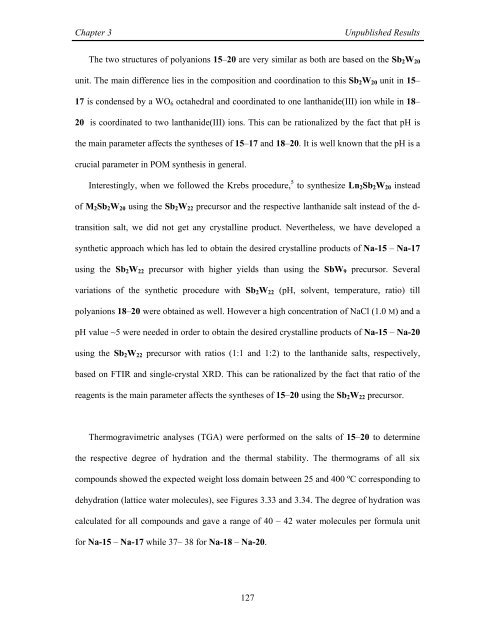Synthesis and Structural Characterization of ... - Jacobs University
Synthesis and Structural Characterization of ... - Jacobs University
Synthesis and Structural Characterization of ... - Jacobs University
You also want an ePaper? Increase the reach of your titles
YUMPU automatically turns print PDFs into web optimized ePapers that Google loves.
Chapter 3<br />
Unpublished Results<br />
The two structures <strong>of</strong> polyanions 15–20 are very similar as both are based on the Sb 2 W 20<br />
unit. The main difference lies in the composition <strong>and</strong> coordination to this Sb 2 W 20 unit in 15–<br />
17 is condensed by a WO 6 octahedral <strong>and</strong> coordinated to one lanthanide(III) ion while in 18–<br />
20 is coordinated to two lanthanide(III) ions. This can be rationalized by the fact that pH is<br />
the main parameter affects the syntheses <strong>of</strong> 15–17 <strong>and</strong> 18–20. It is well known that the pH is a<br />
crucial parameter in POM synthesis in general.<br />
Interestingly, when we followed the Krebs procedure, 5 to synthesize Ln 2 Sb 2 W 20 instead<br />
<strong>of</strong> M 2 Sb 2 W 20 using the Sb 2 W 22 precursor <strong>and</strong> the respective lanthanide salt instead <strong>of</strong> the d-<br />
transition salt, we did not get any crystalline product. Nevertheless, we have developed a<br />
synthetic approach which has led to obtain the desired crystalline products <strong>of</strong> Na-15 – Na-17<br />
using the Sb 2 W 22 precursor with higher yields than using the SbW 9 precursor. Several<br />
variations <strong>of</strong> the synthetic procedure with Sb 2 W 22 (pH, solvent, temperature, ratio) till<br />
polyanions 18–20 were obtained as well. However a high concentration <strong>of</strong> NaCl (1.0 M) <strong>and</strong> a<br />
pH value ~5 were needed in order to obtain the desired crystalline products <strong>of</strong> Na-15 – Na-20<br />
using the Sb 2 W 22 precursor with ratios (1:1 <strong>and</strong> 1:2) to the lanthanide salts, respectively,<br />
based on FTIR <strong>and</strong> single-crystal XRD. This can be rationalized by the fact that ratio <strong>of</strong> the<br />
reagents is the main parameter affects the syntheses <strong>of</strong> 15–20 using the Sb 2 W 22 precursor.<br />
Thermogravimetric analyses (TGA) were performed on the salts <strong>of</strong> 15–20 to determine<br />
the respective degree <strong>of</strong> hydration <strong>and</strong> the thermal stability. The thermograms <strong>of</strong> all six<br />
compounds showed the expected weight loss domain between 25 <strong>and</strong> 400 ºC corresponding to<br />
dehydration (lattice water molecules), see Figures 3.33 <strong>and</strong> 3.34. The degree <strong>of</strong> hydration was<br />
calculated for all compounds <strong>and</strong> gave a range <strong>of</strong> 40 – 42 water molecules per formula unit<br />
for Na-15 – Na-17 while 37– 38 for Na-18 – Na-20.<br />
127

















